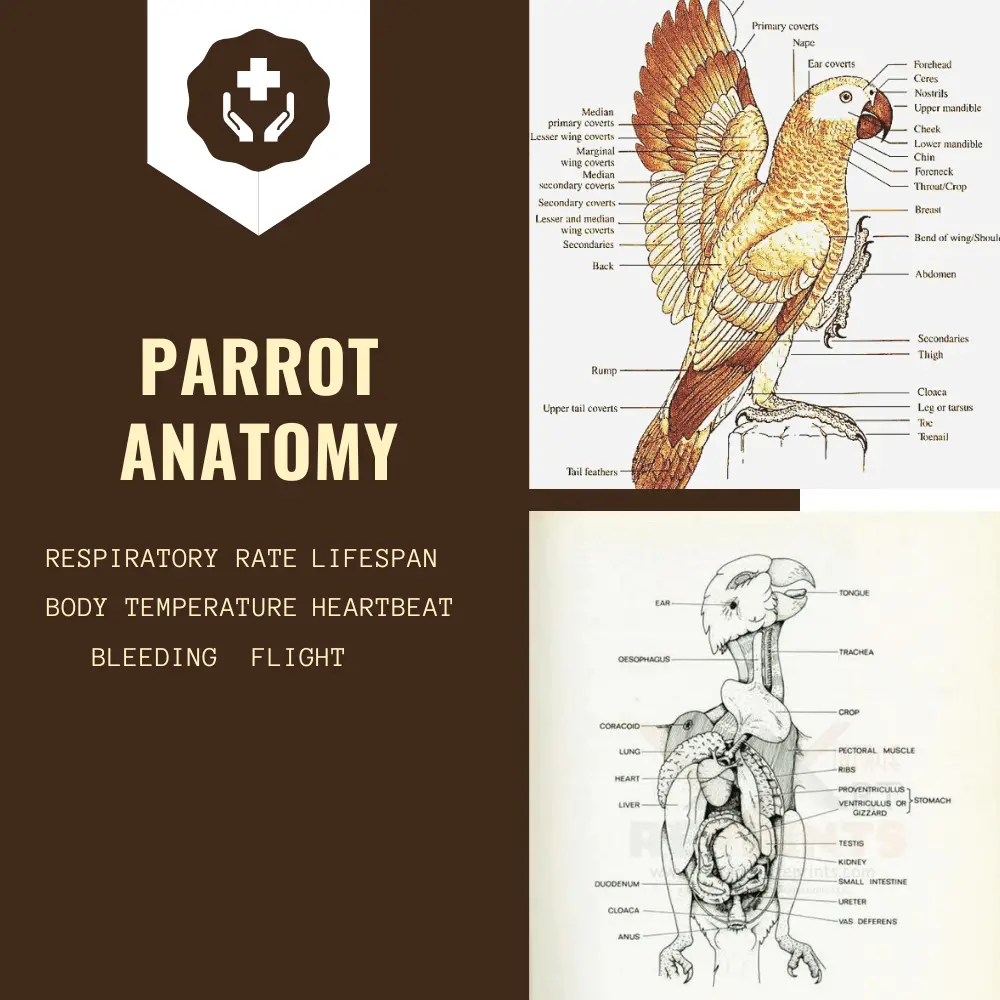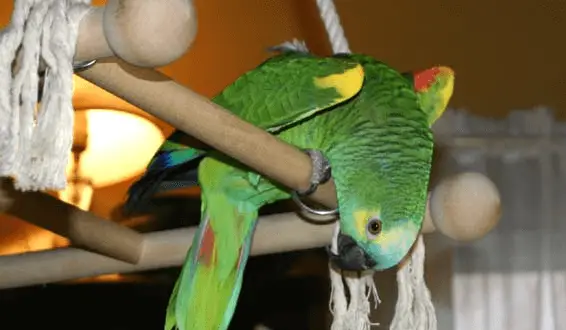
Parrot Anatomy: What catches the eye when looking at a parrot is first and foremost its superb plumage. These flamboyant colors already announce that these birds are unique and fascinating animals. But beyond this plumage, there are peculiarities very specific to birds. Let us stop to observe and understand some of them.
Parrot Body temperature
The normal temperature for your parrot is between 40 and 41 ° C (105 to 107 ° F). Its paws will always feel warm to you. It is therefore difficult to assess whether your bird has a fever, as the body temperature can easily rise momentarily under the effect of emotion or stress.
The legs and beak will then be even warmer. The parrot whose body temperature has climbed opens its wings and gasps much like a dog to cool off.
The respiratory rate

The breathing of a resting parrot is slow and not noisy. He only uses the expansion of his rib cage to create the negative pressure necessary to allow air to enter his lungs.
Since it does not have a diaphragm to help it breathe (a muscle found in most animals that separates the chest and abdomen and contracts with each breath), he is totally dependent on the movements of his chest to breathe.
A parrot easily suffocates death if it is held too tight or in such a way that its thorax cannot be lifted. The respiratory rate normally increases when the bird is stressed, under the effect of restraint, after exercise or if it suffers from a pulmonary pathology.
There is no need to worry if the breathing rate returns to normal within two or three minutes after something that caused it to increase. If this period is longer, a medical evaluation is recommended. The following table gives reference values for the normal respiration of birds. It can serve as a guide to assessing your parrot,
| Weight (grams) |
Respiratory rate at rest: breaths per minute |
| 35 100 200 500 1000 1500 2000 |
60-75 49-52 35-50 20-30 15-20 20-32 19-28 |
For example, we can estimate that an African Gray breathes about 40 times per minute, a parakeet 60 to 75 times, a lovebird 50 to 60, a cockatiel 40 to 50, a small conure 40 to 50, a large conure 30 to 45, an Amazon 15 to 45, a cockatoo 15 to 40, a macaw 20 to 25.
Parrot Heartbeat
Your parrot’s heart beats at breakneck speed even when it is at rest. Auscultation during the veterinary examination is most often used to detect abnormalities in the rhythm or sounds produced by the beats. Heart rate is difficult to determine exactly, especially since the heart beats faster when the bird is held. It is interesting to know that depending on the species, the heart at rest beats at different speeds, here are some examples:
| Heart rate beats per minute |
| Parakeet: 260-270 Lovebird: 240-250 Cockatiel Parakeet: 210-220 Small Conure: 205-220 Large Conure: 165-205 Amazon: 125-160 Cockatoo: 125-170 Macaw: 115-135 |

Parrot flight
The ability to fly is, without a doubt, the most remarkable function of birds. As children, we have all probably tried to imitate our feathered friends by trying to fly by beating the air with our arms.
Quickly, we had to realize that birds had tips and tricks that we didn’t have. Your parrot can therefore fly because nature has endowed it with several very specific characteristics. Here are a few:
- A wide bearing surface created by a strong wing membrane and a large wingspan provided by long wings, terminated in long feathers.
- Lightness ensured by weight savings. The skin is ultra thin ( we can see the muscle through, which gives it its characteristic red color ) and devoid of glands ( only a few sebaceous glands are present in the outer ear and a uropygial gland at the base of the tail participates in the maintenance of plumage (the latter is not present in all species ).
- Your female parrot has only one ovary, the left one. Birds do not have teeth and their beaks are made of solid materials, but very light at the same time.
- Their bodies are filled with empty, air-filled cavities ( the air sacs ). The bones are hollow, strong and flexible. Some are merged. For the same surface area, the weight of the skeleton of the bird is half the weight of that of mammals. Depending on the species, there are 120 to 170 bones.
- Urine is concentrated ( saving water and space ) and is not stored in a bladder. It is evacuated with the stool.
- The intestine is short, which makes it impossible to store too much material that could be heavy to carry.
- A powerful musculature supported by a very efficient respiratory and cardiac system.
Parrot Bleeding
Watching your parrot bleed is always very stressful. Everyone agrees that he can die quickly at the end of his blood. It is well known that there are no liters of this precious liquid inside your parrot.
There is still enough of it to handle moderate bleeding. It is estimated that there are approximately 10 ml of blood per 100 grams of bodyweight inside a healthy bird. This represents about 40 ml in total for a 400-gram Amazon.
Did you know that birds generally cope with significant blood loss better than mammals? During bleeding, their body is better suited to quickly and effectively mobilize extravascular fluids to maintain adequate blood pressure.
Most people are surprised to learn that a bird can lose a lot of blood without endangering its life. More specifically, your bird can lose an amount of blood equivalent to 1% of its weight without this being serious.
This means for the 400-gram Amazon that he can lose 4 ml without causing any concern! He can even lose up to 3ml per 100 grams of body weight, i.e. 12ml, before the situation is deemed serious to his health.
This data should not prevent you from responding promptly to a bleeding bird. However, they help to relativize the seriousness of the situation after the bleeding is controlled: one does not worry if a large parrot has lost a few drops of blood.
your bird can lose blood equivalent to 1% of its body weight without causing serious harm. This means for the 400-gram Amazon that he can lose 4 ml without causing any concern! He can even lose up to 3ml per 100 grams of body weight, i.e. 12ml, before the situation is deemed serious to his health.
He can even lose up to 3ml per 100 grams of body weight, i.e. 12ml, before the situation is deemed serious to his health. This data should not prevent you from responding promptly to a bleeding bird.
However, they help to relativize the seriousness of the situation after the bleeding is controlled: one does not worry if a large parrot has lost a few drops of blood.
He can even lose up to 3ml per 100 grams of body weight, i.e. 12ml, before the situation is deemed serious to his health. This data should not prevent you from responding promptly to a bleeding bird.
However, they help to relativize the seriousness of the situation after the bleeding is controlled: one does not worry if a large parrot has lost a few drops of blood.
Parrot lifespan
In closing, it is interesting to highlight the surprising longevity of several parrots. It is sometimes surprising that such small creatures can live so long. Some records have been documented:
- parakeet: 18 years old
- Lovebird: 19 years
- cockatiel parakeet: 32 years old
For other large parrots, it is reasonable to expect that they will keep us company for at least 50 to 80 years.




















